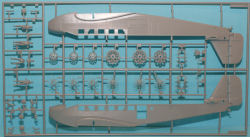
Pro-Modeler 1/48 Ju 52/3m Kit First Look
By Michael Benolkin
| Date of Review | January 2009 (Revised March 2018) | Manufacturer | Pro-Modeler |
|---|---|---|---|
| Subject | Ju 52/3m | Scale | 1/48 |
| Kit Number | 5944 | Primary Media | Styrene |
| Pros | Best Ju 52 kit in any scale | Cons | See text |
| Skill Level | Experienced | MSRP (USD) | See text |
First Look
 |
 |
 |
 |
 |
 |
The Junkers Ju 52 was a transport aircraft scaled up from the earlier W33. The type was first flown in the early 1930s and was produced between 1932 and 1945. These early Junkers transports, like the Ford Tri-Motor, relied on corrugated metal skin to provide greater strength with less weight - a flying Quonset Hut.
During the early 1930s, the Ju 52 was used extensively in commercial air transport with Lufthansa and exported to other countries as well. The first Ju 52s were actually single-engined aircraft which were later denoted as Ju 52/1m (one motor) while the most-widely produced version was the trimotor Ju 52/3m.
The Ju 52 was inducted into military service in 1935 and went into combat during the Spanish Civil War as both a bomber and a transport. The type became one of the principal airlifters of the Luftwaffe throughout the war, though like the C-47, the Ju 52 was neither fast nor maneuverable, and was therefore a target in areas where enemy fighters could be found. One good example of this was near the end of the North African campaign where 24 Ju 52s were shot down and another 35 seriously damaged by allied fighters during the 'Palm Sunday Massacre'. JG 27 was tasked to cover the transports, and they only claimed one kill in return.
While most of the Ju 52s were destroyed by war's end, the type was so versatile that Amiot of France produced the aircraft as the AAC1 Toucan after the war. CASA of Spain also produced the aircraft after the war as the CASA 352.
Monogram surprised the hobby world with this kit which expanded their already-impressive resume of beautiful 1/48 aircraft kits. Initially released under the Monogram banner, this kit lives up to the high standard of detail and simplicity all in one package. First released in 1998 under the Monogram banner, this kit was reissued again in 1999 under the Pro Modeler banner with a few tweaks to render the early Spanish Civil War dorsal and ventral gun 'turrets', weighted wheels, and a few other options. Revell Germany followed that release with a civilian version of the Ju 52 with 1936 Olympic markings. The kit continues to be regularly reissued and can be found today in retail stores.
Molded in light gray styrene, this kit presented on four parts trees, plus a single tree of clear parts. This was the first time I had seen Revell use connecting pins to lock sprue trees together to keep them from rattling around during shipping. Come to think of it, I don't recall seeing this technique again in a Revell box, though this technique of interlocking trees is also in use by a few other companies.
The issue of raised versus scribed detailing is moot on a project like this one where virtually the entire surface of the model is corrugated. Nevertheless, the detailing is nicely done and it is still impressive to see how much detail Monogram can design into a kit without making it overly complicated to build.
Among the features and options in this kit:
- Beautifully detailed flight deck
- Pilot/copilot seats would benefit from aftermarket crew restraints
- Very detailed main cabin
- Positionable main cabin door (port side)
- Optional positionable cargo door (starboard side - see notes)
- Optional positionable overhead cargo door (see notes)
- Positionable elevators
- Weighted main wheels
- Pro-Modeler version has optional spatted undercarriage
- Detailed engines
- Choice of shallow or deep center engine cowling
- Optional forward gun ring
- Optional paratrooper figures (4)
Markings are provided for two aircraft:
- Ju 52/3mg4e, Grupo de Bombardeo Nocturno (Night Bombing Group), 22-101, Spanish Nationalist
- Ju 52/3mg7e, 1Z+LK, 1.Staffel, KGzbV1, Milos, Greece, 1941
Notes:
- The kit has the starboard cargo doors and overhead cargo door molded closed, but with nice cut-lines molded inside. These can be easily positioned open for diorama or display purposes
- The kit provides the rear gunner's station and the option for a forward (aft of flight deck) gunner's station. The flight deck transparency has the gunner's access open but a clear panel is also included to render the aircraft without the forward gunner's station
- There are a few areas in the instructions where the parts placement is a bit ambiguous, but if you look closely and test-fit your parts, you'll get past those areas easily enough
Overall, this is another excellent example of how Monogram's kits remain relevant by today's standards by providing beautiful detail without excessive over-engineering and numerous tiny parts found in many of today's kits. I don't know what the latest pricing is on this kit (or the same kit in other Monogram releases) range from $22 USD to $44 USD from a variety of online retail resources. If you don't have one of these kits in your collection, you can shop around and find one quite easily.







